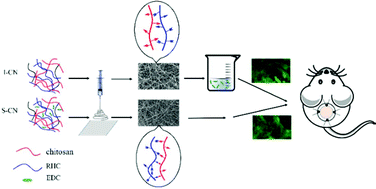当前位置:
X-MOL 学术
›
Biomater. Sci.
›
论文详情
Our official English website, www.x-mol.net, welcomes your feedback! (Note: you will need to create a separate account there.)
Electrospinning of in situ crosslinked recombinant human collagen peptide/chitosan nanofibers for wound healing†
Biomaterials Science ( IF 6.6 ) Pub Date : 2018-07-05 00:00:00 , DOI: 10.1039/c8bm00492g Aipeng Deng 1, 2, 3, 4 , Yang Yang 5, 6, 7, 8 , Shimei Du 1, 2, 3, 4 , Shulin Yang 1, 2, 3, 4
Biomaterials Science ( IF 6.6 ) Pub Date : 2018-07-05 00:00:00 , DOI: 10.1039/c8bm00492g Aipeng Deng 1, 2, 3, 4 , Yang Yang 5, 6, 7, 8 , Shimei Du 1, 2, 3, 4 , Shulin Yang 1, 2, 3, 4
Affiliation

|
Electrospun collagen nanofibers are effective for wound healing; however, many problems, such as the tedious preparation process, weak strength and poor structure integration, limit further applications. In this study, recombinant human collagen (RHC) peptides and a simple one-step crosslinking strategy were used to prepare RHC/chitosan nanofibers. With the nonpathogenic, water-soluble RHC and a mild electrospinning solvent, in situ crosslinked nanofibers (S-CN) not only simplified the preparation procedure but also maintained a more integrated morphology. Compared with the immersed crosslinked nanofibers (I-CN), S-CN showed better performance in moisture retention, degradation and mechanical strength tests. In vitro cell proliferation, morphology and RT-PCR studies confirmed that fibroblasts presented better activities on nanofibers crosslinked in situ. Importantly, after treating with the nanofibers, rapid epidermidalization and angiogenesis were observed in an SD rat scalding model. All these data suggest that electrospun RHC/chitosan nanofibers crosslinked in situ are an ideal candidate that can be used for wound healing applications.
中文翻译:

的静电纺丝在原位交联的重组人胶原蛋白肽/壳聚糖纳米纤维为伤口愈合†
电纺胶原蛋白纳米纤维可有效治愈伤口。然而,许多问题,例如繁琐的制备过程,强度低和结构整合性差,限制了其进一步的应用。在这项研究中,重组人胶原蛋白(RHC)肽和简单的一步交联策略用于制备RHC /壳聚糖纳米纤维。使用非病原性水溶性RHC和温和的电纺丝溶剂,原位交联纳米纤维(S-CN)不仅简化了制备过程,而且保持了更加完整的形态。与浸渍的交联纳米纤维(I-CN)相比,S-CN在保水性,降解和机械强度测试中表现出更好的性能。体外细胞增殖,形态学和RT-PCR研究证实,成纤维细胞对原位交联的纳米纤维表现出更好的活性。重要的是,用纳米纤维处理后,在SD大鼠烫伤模型中观察到了快速的表皮形成和血管生成。所有这些数据表明,原位交联的静电纺丝RHC /壳聚糖纳米纤维是可用于伤口愈合应用的理想候选材料。
更新日期:2018-07-05
中文翻译:

的静电纺丝在原位交联的重组人胶原蛋白肽/壳聚糖纳米纤维为伤口愈合†
电纺胶原蛋白纳米纤维可有效治愈伤口。然而,许多问题,例如繁琐的制备过程,强度低和结构整合性差,限制了其进一步的应用。在这项研究中,重组人胶原蛋白(RHC)肽和简单的一步交联策略用于制备RHC /壳聚糖纳米纤维。使用非病原性水溶性RHC和温和的电纺丝溶剂,原位交联纳米纤维(S-CN)不仅简化了制备过程,而且保持了更加完整的形态。与浸渍的交联纳米纤维(I-CN)相比,S-CN在保水性,降解和机械强度测试中表现出更好的性能。体外细胞增殖,形态学和RT-PCR研究证实,成纤维细胞对原位交联的纳米纤维表现出更好的活性。重要的是,用纳米纤维处理后,在SD大鼠烫伤模型中观察到了快速的表皮形成和血管生成。所有这些数据表明,原位交联的静电纺丝RHC /壳聚糖纳米纤维是可用于伤口愈合应用的理想候选材料。



























 京公网安备 11010802027423号
京公网安备 11010802027423号